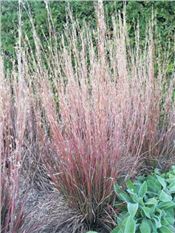Gardening Page
Native Prairie Grasses Create Distinct, Breezy Aesthetic In Home Landscape

Little bluestem is a native prairie grass with beauty in all four seasons, including excellent fall color.
Photo by Ryan Pankau
RYAN PANKAU
URBANA, ILLINOIS
Nothing beats the light and airy look of tall, distinctive grasses in a landscape arrangement. The fluffy seedheads and slender, attractive stems practically dance in the wind on breezy days, adding texture as well as a structural element to any landscape bed.
For many years, there was a trend toward non-native grasses, says Ryan Pankau, University of Illinois Extension horticulture educator.
“However, there is a growing interest in native prairie grasses, given their inherent adaptability to our climate and their ecological value,” Pankau says.
Big Bluestem, Andropogon gerardii, is one of his favorites for its wonderful height, sometimes reaching up to 8 feet including the seedheads. It’s known for attractive, blue-green foliage and steams that fade to reddish-bronze in fall. Interesting seed heads develop late in the growing season and persist into winter.
Big bluestem fits well in the rear of a border planting or as a backdrop for other, shorter natives. It also works nicely in mass plantings or as a visual screen when planted in groups. It can be maintained as somewhat of a specimen when mixed into native plantings, although it does tend to slowly spread by rhizomes over time. Spread can be limited by other competing prairie plants or by periodic removal of spreading shoots.
Switchgrass, Panicum virgatum, is another very tall native grass used for both its ornamental appeal and its tough adaptability to a wide range of soil conditions. However, one issue with switchgrass is its innate ability to spread, either from rhizomes or by seed. For this reason, it’s probably better used in mass plantings or as a solid border to create visual screening. It works well in problem areas such as wet spots, areas with erosion or locations with some partial shade.
“While switchgrass can have a really nice fall color, I think its seedheads provide the most interest,” Pankau says. As seedheads mature and expand late in the growing season, they created a cloud- like effect with their open and airy form.
Little bluestem, Schizachyrium scoparium, packs a ton of beauty into shorter stems and fluffier seedheads. Foliage and stems emerge with a deep blue-green color that matures to lighter green with reddish accents at stem nodes. In late summer, flowers begin to emerge as beautiful purplish-red structures that mature into fluffy tufts.
Perhaps the plant’s greatest beauty lies in its wonderful fall color creating a spectacular reddish-purple color. Little bluestem works well as a more vertical component that is not overly tall at only 2 to 4 feet by the season’s end. It works well in a great variety of garden uses, from mass plantings to small pollinator pockets.
“In my opinion, it is one of the most beautiful and colorful of our native grasses, and it behaves well as it is slow to spread retaining a clump-like habit,” Pankau says.
Another smaller native grass that works well in the landscape is prairie dropseed, Sporobolus heterolepis. While it does have interesting seed heads and nice fall color, this plant has most value in its fine-textured foliage during the growing season and much smaller size at around 2 feet in height.
Pankau says this is one of his favorite plants to add along a sidewalk or at the front edge of a native garden. It creates a welcoming and inviting view with its fine-textured, hair-like foliage that wonderfully frames the planting.
“It’s a highly underused landscape plant that deserves more attention given its overall low maintenance requirements and well- behaved habit,” he says. ∆
RYAN PANKAU: University of Illinois